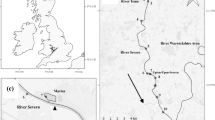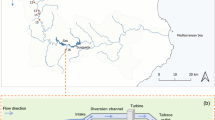Abstract
To determine the actual status of the recruiting glass eel stock of Anguilla japonica, we conducted a continuous monthly monitoring program for 2 years between November 2009 and October 2011 at the Sagami River estuary, Japan. A total of 114 and 372 A. japonica glass eels were observed in the 2009–2010 and 2010–2011 seasons, respectively. Recruitment patterns were the same in both years, starting in early winter (December in 2009 and November in 2010), increasing slightly until March, decreasing in April, but attaining the largest peak in June, after which no glass eels were observed during August–October. The Japanese eel has been known to spawn mainly in the summer, and glass eels recruit to their freshwater growth habitats during the winter to early spring. Our results clearly demonstrate an unexpected late arrival of glass eels in the early summer for two recent consecutive year classes. The summer recruitment found in our study indicates the unusual phenology of the Japanese eel, which may be a possible response to recent climate change.


Similar content being viewed by others
References
Matsui I (1972) Eel biology: aquaculture techniques (in Japanese). Koseisha-Koseikaku, Tokyo
Food and Agriculture Organization (FAO) (2010) Fishery and aquaculture statistics, FAO yearbook 2008. FAO, Rome
Ministry of Agriculture, Forestry and Fisheries, Japan (2011) The 85th statistical year book of the Ministry of Agriculture, Forestry and Fisheries (2009–2010). Ministry of Agriculture, Forestry and Fisheries, Tokyo
Ege V (1939) A revision of the genus Anguilla Shaw, a systematic, phylogenetic and geographical study. Dana Rep 16:1–256
Watanabe S (2003) Taxonomy of the freshwater eels, genus Anguilla Schrank, 1798. In: Aida K et al (eds) Eel biology. Springer, Tokyo, pp 3–18
Tsukamoto K, Chow S, Otake T, Kurogi H, Mochioka N, Miller MJ, Aoyama J, Kimura S, Watanabe S, Yoshinaga T, Shinoda A, Kuroki M, Oya M, Watanabe T, Hata K, Ijiri S, Kazeto Y, Nomura K, Tanaka H (2011) Oceanic spawning ecology of freshwater eels in the western North Pacific. Nat Commun 2:179
Shinoda A, Aoyama J, Miller MJ, Otake T, Mochioka N, Watanabe S, Minegishi Y, Kuroki M, Yoshinaga T, Yokouchi K, Fukuda N, Sudo R, Hagihara S, Zenimoto K, Suzuki Y, Oya M, Inagaki T, Kimura S, Fukui A, Lee TW, Tsukamoto K (2011) Evaluation of the larval distribution and migration of the Japanese eel in the western North Pacific. Rev Fish Biol Fish 21:591–611
Han YS (2011) Temperature-dependent recruitment delay of the Japanese glass eel Anguilla japonica in East Asia. Mar Biol 158:2349–2358
Tsukamoto K (1990) Recruitment mechanism of the eel, Anguilla japonica, to the Japanese coast. J Fish Biol 36:659–671
Shinoda A, Tsukamoto K (2009) The early life history and migration of Japanese eel larvae. Am Fish Soc Symp 69:879–881
Cheng PW, Tzeng WN (1996) Timing of metamorphosis and estuarine arrival across the dispersal range of the Japanese eel Anguilla japonica. Mar Ecol Prog Ser 131:87–96
Kawakami Y, Mochioka N, Nakazono A (1999) Immigration patterns of glass-eels Anguilla japonica entering river in northern Kyushu, Japan. Bull Mar Sci 64:315–327
Tzeng WN (1985) Immigration timing and activity rhythms of the eel, Anguilla japonica, elvers in the estuary of northern Taiwan, with emphasis on environmental influences. Bull Jpn Soc Fish Oceanogr 47:11–28
Kawakami Y, Mochioka N, Morishita K, Toh H, Nakazono A (1998) Determination of the freshwater mark in otoliths of Japanese eel elvers using microstructure and Sr/Ca ratios. Environ Biol Fish 53:421–427
Shinoda A (2004) The ecology of inshore migration of the Japanese eel, Anguilla japonica (in Japanese). PhD dissertation. University of Tokyo, Tokyo
Han YS, Tzeng WN, Liao IC (2009) Time series analysis of Taiwanese catch data of Japanese glass eels Anguilla japonica: possible effects of the reproductive cycle and El Niño Events. Zool Stud 48:632–639
Dekker W (2004) Slipping through our hands: population dynamics of the European eel. PhD dissertation. University of Amsterdam, the Netherlands
Ministry of Agriculture, Forestry and Fisheries, Japan (2012) Annual statistics of fishery and aquaculture. Ministry of Agriculture, Forestry and Fisheries, Tokyo
Tsukamoto K, Aoyama J, Miller MJ (2009) Present status of the Japanese eel: resources and recent research. In: Casselman JM, Cairns DK (eds) Eels at the edge: science, status and conservation concerns. American Fisheries Society Symposium, Bethesda, pp 21–35
Tzeng WN, Tseng YH, Han YS, Hsu CC, Chang CW, Di Lorenzo E, Hsieh CH (2012) Evaluation of multi-scale climate effects on annual recruitment levels of the Japanese eel, Anguilla japonica, to Taiwan. PLoS ONE 7:e30805
Han YS, Hung CL, Liao YF, Tzeng WN (2010) Population genetic structure of the Japanese eel Anguilla japonica: panmixia at spatial and temporal scales. Mar Ecol Prog Ser 401:221–232
Fukuda N (2010) Study on the recruitment mechanisms in the Japanese eel Anguilla japonica in Hamana Lake system (in Japanese). PhD dissertation. University of Tokyo, Tokyo
Strubberg A (1913) The metamorphosis of elvers as influenced by outward conditions. Meddr Kommn Havunders Ser Fisk 4:1–11
Bertin L (1956) Eels—a biological study. Cleaver-Hume Press, London
Elie P, Lecomte-Finiger R, Cantrelle I, Charlon NV (1982) Definition des limites des differents stades pigmentaires durant la phase civelle d’ Anguilla anguilla L (in French with English abstract). Vie Milieu 32:149–157
Tesch FW (2003) The eel, 3rd edn. Blackwell Science/Fisheries Society of the British Isles, Oxford
Tabeta O, Tanimoto T, Takai T, Matsui I, Imamura T (1976) Seasonal occurrence of anguillid elvers in Cagayan River, Luzon Island, the Philippines. Nippon Suisan Gakkaishi 42:421–426
Leander NJ, Shen KN, Chen RT, Tzeng WN (2012) Species composition and seasonal occurrence of recruiting glass eels (Anguilla spp.) in the Hsiukuluan River, eastern Taiwan. Zool Stud 51:59–71
Yoshinaga T, Miller MJ, Yokouchi K, Otake T, Kimura S, Aoyama J, Watanabe S, Shinoda A, Oya M, Miyazaki S, Zenimoto K, Sudo R, Takahashi T, Ahn H, Manabe R, Hagihara S, Morioka H, Itakura H, Machida M, Ban K, Shiozaki M, Ai B, Tsukamoto K (2011) Genetic identification and morphology of naturally spawned eggs of the Japanese eel Anguilla japonica collected in the western North Pacific. Fish Sci 77:983–992
Tsukamoto K (1989) Otolith daily increments in the Japanese eel. Nippon Suisan Gakkaishi 55:1017–1021
Umezawa A, Tsukamoto K, Tabeta O, Yamakawa H (1989) Daily growth increments in the larval otolith of the Japanese eel, Anguilla japonica. Jpn J Ichthyol 35:440–444
Umezawa A, Tsukamoto K (1991) Factors influencing otolith increment formation in Japanese eel, Anguilla japonica T. and S., elvers. J Fish Biol 39:211–223
Shinoda A, Tanaka H, Kagawa H, Ohta H, Tsukamoto K (2004) Otolith micro structural analysis of reared larvae of the Japanese eel Anguilla japonica. Fish Sci 70:339–341
Fukuda N, Kuroki M, Shinoda A, Yamada Y, Okamura A, Aoyama J, Tsukamoto K (2009) Influence of water temperature and feeding regime on otolith growth in Anguilla japonica glass eels and elvers: does otolith growth cease at low temperatures? J Fish Biol 74:1915–1933
Lecomte-Finiger R (1992) Growth history and age at recruitment of European glass eels (Anguilla anguilla) as revealed by otolith microstructure. Mar Biol 114:205–210
Inaba S, Yamamoto S (1938) Glass eels and aquaculture (in Japanese). Month Rep Fish Res Agen Shizuoka Pref 47:19–32
Yamamoto T, Mochioka N, Nakazono A (2001) Seasonal occurrence of anguillid glass eels at Yakushima Island, Japan. Fish Sci 67:520–532
Tsukamoto K, Nakai I, Tesch WV (1998) Do all freshwater eels migrate? Nature 396:635–636
Lee WC, Chen YH, Lee YC, Liao IC (2003) The competitiveness of the eel aquaculture in Taiwan, Japan, and China. Aquaculture 221:115–124
Tanaka H, Kagawa H, Ohta H, Unuma T, Nomura K (2003) The first production of glass eel in captivity: fish reproductive physiology facilitates great progress in aquaculture. Fish Physiol Biochem 28:493–497
Chow S, Kurogi H, Mochioka N, Kaji S, Okazaki M, Tsukamoto K (2009) Discovery of mature freshwater eels in the open ocean. Fish Sci 75:257–259
Kurogi H, Okazaki M, Mochioka N, Jinbo T, Hashimoto H, Takahashi M, Tawa A, Aoyama J, Shinoda A, Tsukamoto K, Tanaka H, Gen K, Kazeto Y, Chow S (2011) First capture of post-spawning female of the Japanese eel Anguilla japonica at the southern West Mariana Ridge. Fish Sci 77:199–205
Parmesan C (2006) Ecological and evolutionary responses to recent climate change. Annu Rev Ecol Evol Syst 37:637–669
Wedekind C, Küng C (2010) Shift of spawning season and effects of climate warming on developmental stages of a grayling (Salmonidae). Conserv Biol 24:1418–1423
Acknowledgments
We wish to thank K. Kumagiri, S. Tsubaki and T. Fushiguro who provided useful information on glass eel fishing. The authors also thank the following people who supported the sampling survey of this study: S. Ai, M. Oya, M. Nakamura, H. Itakura, M. Ishikawa, Y. Shibuta and S. Nakazato. Thanks are also due to Y. Ishiguro and M. Aikawa of the Fishery Division of the Kanagawa Prefectural Government for their discretion in allowing the sample collection and providing catch data of the glass eels. We are grateful to the editor and two anonymous reviewers for providing constructive comments to improve the manuscript. Critical comments and corrections from M.J. Miller are also highly appreciated. This study was partially supported by a grant-in-aid (no. 21405024) from the Japan Society for the Promotion of Science, and the Cooperative Program (no. 122, 2011) by the Atmosphere and Ocean Research Institute of the University of Tokyo.
Author information
Authors and Affiliations
Corresponding author
Rights and permissions
About this article
Cite this article
Aoyama, J., Shinoda, A., Yoshinaga, T. et al. Late arrival of Anguilla japonica glass eels at the Sagami River estuary in two recent consecutive year classes: ecology and socio-economic impacts. Fish Sci 78, 1195–1204 (2012). https://doi.org/10.1007/s12562-012-0544-y
Received:
Accepted:
Published:
Issue Date:
DOI: https://doi.org/10.1007/s12562-012-0544-y




